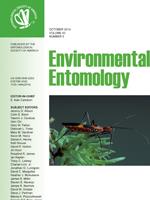The hemlock woolly adelgid (Adelges tsugae Annand) has decimated eastern hemlocks (Tsuga canadensis Carrière) in forests throughout the eastern United Sates, but its densities in central NewEngland appear to have stabilized. To find out why, we infested 64 eastern hemlocks with varying densities of adelgid ovisacs in a typical eastern hemlock forest in western Massachusetts. We subsequently documented adelgid density, fecundity, and the amount of new growth on experimental trees over two consecutive years. We used a 2 by 2 randomized block design using previously and newly infested hemlocks that were either 1-m tall saplings or branches of mature trees. There was a density-dependent decline in the survival and fecundity of adelgid in both the spring and winter generations. This response was a function of both previous infestation by adelgid and current year's crawler density in the spring generation. Additionally, the production of sexuparae in the spring generation played a key role in the overall density-dependent survival of adelgid, suggesting that sexuparae production is strongly linked to developing crawler density.
How to translate text using browser tools
1 October 2014
Density-Dependent Survival and Fecundity of Hemlock Woolly Adelgid (Hemiptera: Adelgidae)
Elizabeth M. Sussky,
Joseph S. Elkinton
ACCESS THE FULL ARTICLE
It is not available for individual sale.
This article is only available to subscribers.
It is not available for individual sale.
It is not available for individual sale.

Environmental Entomology
Vol. 43 • No. 5
October 2014
Vol. 43 • No. 5
October 2014
density dependence
forest insect
population regulation
sexuparae




